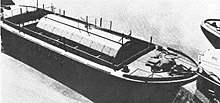
Barge often refers to a flat-bottomed inland waterway vessel which does not have its own means of mechanical propulsion. The first modern barges were pulled by tugs, but on inland waterways, most are pushed by pusher boats, or other vessels. The term barge has a rich history, and therefore there are many other types of barges.

The landing craft, tank (LCT) was an amphibious assault craft for landing tanks on beachheads. They were initially developed by the Royal Navy and later by the United States Navy during World War II in a series of versions. Initially known as the "tank landing craft" (TLC) by the British, they later adopted the U.S. nomenclature "landing craft, tank" (LCT). The United States continued to build LCTs post-war, and used them under different designations in the Korean and Vietnam Wars.
Concrete ships are built primarily with ferrocement hulls, reinforced with steel bars. This contrasts against more traditional materials, such as pure steel or wood. The advantage of ferrocement construction is that materials are cheap and readily available, while the disadvantages are that construction labor costs are high, as are operating costs. During the late 19th century, there were concrete river barges in Europe, and during both World War I and World War II, steel shortages led the US military to order the construction of small fleets of ocean-going concrete ships, the largest of which was the SS Selma. United States Maritime Administration (MARAD) designation for concrete ships-barges was Type B ship. Few concrete ships were completed in time to see wartime service during World War I, but during 1944 and 1945, concrete ships and barges were used to support U.S. and British invasions in Europe and the Pacific. Since the late 1930s, there have also been ferrocement pleasure boats.

Manitowoc Shipbuilding Company, located in Manitowoc, Wisconsin, was a major shipbuilder for the Great Lakes. It was founded in 1902, with the purchase of the "Burger & Burger Shipyard," a predecessor to The Burger Boat Company, and made mainly steel ferries and ore haulers. During World War II, it built submarines, tank landing craft (LCTs), and self-propelled fuel barges called "YOs". Employment peaked during the military years at 7000. The shipyard closed in 1968, when Manitowoc Company bought Bay Shipbuilding Company and moved their shipbuilding operation to Sturgeon Bay.
USS YO-257 was a Yard Oiler of the United States Navy that was launched in the early 1940s and scuttled two miles off Waikiki, Honolulu, Hawaii in 1989.

USS Eastern Light (ID-3538) was an Emergency Fleet Corporation (EFC) Design 1127 cargo steamship that was built in Japan in 1918 for the United States Shipping Board (USSB). From December 1918 to April 1919 she spent five months in the United States Navy. In 1926 she was sold and renamed Willkeno. She was renamed Isthmian in 1937 and Illinoian in 1939. in 1944 she was scuttled off the coast of Normandy as Blockship 485.

The Type V ship is a United States Maritime Commission (MARCOM) designation for World War II tugboats. Type V was used in World War II, Korean War, and the Vietnam War. Type V ships were used to move ships and barges. Type V tugboats were made of either steel or wood hulls. There were four types of tugboats ordered for World War II. The largest type V design was the sea worthy 186-foot (57 m) long steel hull, V4-M-A1. The V4-M-A1 design was used by a number of manufacturers; a total of 49 were built. A smaller steel hull tugboat was the 94-foot (29 m) V2-ME-A1; 26 were built. The largest wooden hull was the 148-foot (45 m) V3-S-AH2, of which 14 were built. The smaller wooden hull was the 58-foot (18 m) V2-M-AL1, which 35 were built. Most V2-M-AL1 tugboats were sent to the United Kingdom for the war efforts under the lend-lease act. The Type V tugs served across the globe during World War II including: Pacific War, European theatre, and in the United States. SS Farallon, and other Type V tugs, were used to help built Normandy ports, including Mulberry harbour, on D-Day, 6 June 1944, and made nine round trips to Normandy to deliver Phoenix breakwaters.
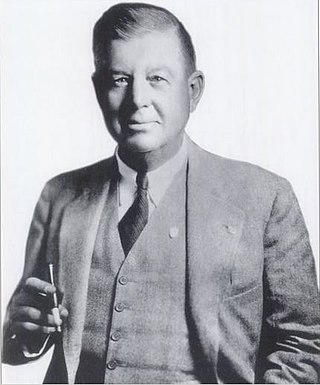
Pacific Bridge Company was a large engineering and construction company. During World War II, Pacific Bridge Company of Alameda, California was selected to build US Navy Auxiliary Repair Docks (ARD) a type of Auxiliary floating drydock and Type B ship barges.
Everett-Pacific Shipbuilding & Dry Dock Company was established in 1942 to build ships needed for World War II. Yard construction began on 1 March 1942. As part of the Emergency Shipbuilding Program, the US Navy provided some of the capital to start Everett-Pacific Shipbuilding at Port Gardner Bay in Everett, Washington. Everett-Pacific was sold in 1945 to the Pacific Car and Foundry, who was already a major manufacturer of railcars and trucks. Pacific Car and Foundry was building barges for the US Navy during World War II at plants in Renton, Seattle and Tacoma in the state of Washington. The lease for the shipyard in Everett, Washington ended in 1949 and the yard closed. Pacific Car and Foundry in 1972 changed its name to Paccar Inc. to reflect its major products. The Everett-Pacific shipyard site later became part of Western Gear, a heavy machinery manufacturer. From 1987 to 1992, the shipyard was rebuilt to become part of Naval Station Everett. Everett-Pacific Shipbuilding was started by William Pigott Jr. a Seattle businessmen and his brother Paul Pigott (1900-1961). William Pigott Jr. was born in 26 Aug. 1895 in Pueblo, CO and died on 8 July 1947 in San Francisco, CA.
Pollock-Stockton Shipbuilding Company was established in 1942 to build ships needed for World War II. As part of the Emergency Shipbuilding Program the US Navy provided some of the capital to start Pollock-Stockton Shipbuilding at Stockton, California. The shipyard was located at San Joaquin River and Stockton Channel, near Louis Park. After the war the shipyard closed down in February 1946.

Albina Engine & Machine Works was a shipyard along the Willamette River in Portland, Oregon, United States. It was located in the Albina area of Portland along N. River Street and N. Loring Street. Albina Engine & Machine Works was founded in 1904. The shipyard produced a number of freighters during World War I, but operated mainly as a repair yard during the 1920s and 1930s. The Albina yard expanded its workforce and production during Portland's World War II shipbuilding boom. It specialized in producing subchasers, vessels designed to combat German U-boats. Albina Engine & Machine Works also built Landing Craft Support boats and cargo ships. Business declined in the post-war years, and Albina Engine & Machine Works was sold to the Dillingham Corporation around 1971.

USS YOG-42 was a gasoline barge built by Concrete Ship Constructors, in National City, California. She was launched on March 23, 1943. Acquired by the United States Navy on May 23, 1943. She was assigned to the Asiatic-Pacific Theater, and survived the war. Re-designated YOGN-42 in May 1946, she was struck from the Naval Register on August 15, 1949. Sometime the next year, she was intentionally beached on the north coast of Lānaʻi in the Hawaiian Islands.
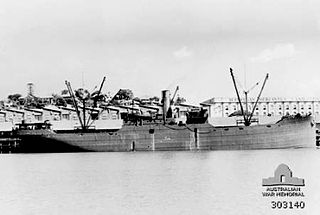
The Design 1023 ship was a steel-hulled cargo ship design approved for mass production by the United States Shipping Board's (USSB) Emergency Fleet Corporation (EFC) in World War I. Like many of the early designs approved by the EFC, the Design 1023 did not originate with the EFC itself but was based on an existing cargo ship designed by Theodore E. Ferris for the United States Shipping Board (USSB). The ships, to be built by the Submarine Boat Corporation of Newark, New Jersey, were the first to be constructed under a standardized production system worked out by Ferris and approved by the USSB.
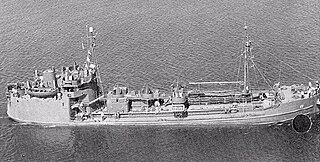
Kyle & Company or Kyle & Co was a steel shipbuilding company in Stockton, California. To support the World War II demand for ships Kyle & Company built: coastal tankers and Type B ship deck barges. Kyle & Company was opened as a manufacturer of steel products and build ships for the war. After World War II, the shipyard closed in 1950 and was purchased by Pittsburgh-Des Moines Steel Co. Kyle & Company also made steel products in Fresno and Sacramento. The shipyard was located on the Stockton Channel at 348 North Harrison Street, now a parking lot near Banner Stadium and Stockton Arena. The Kyle & Company shipyard was on the deepwater port on the Stockton Ship Channel of the Pacific Ocean and an inland port located more than seventy nautical miles from the ocean, on the Stockton Channel and San Joaquin River-Stockton Deepwater Shipping Channel.

Moore Equipment Company was founded in 1929 by Stanley S. Moore and his father in Stockton, California. Moore Equipment Company a repair and manufacture company of farm machines, road machines and tools. To support the World War 2 demand for ships Moore Equipment Company built a shipyard and switched over to military construction and built: US Navy YSD-11 Class Seaplane Wrecking Derricks, landing craft and barges. Moore Equipment Company also did work for the US Army repairing and rebuilding jeeps by way of the Ford Motor in Richmond. The shipyard also did Navy ship repair. Moore Equipment Company's main work before the war was on tractors, cranes, trucks, bulldozers, power winches, road scrapers and tools. The Moore Equipment Company office was at 1250 South Wilson Way, Stockton, now the Fairgrounds Industrial Park. Equipment Company sold the factory on February 15, 1944 to International Harvester Company. The shipyard closed after the war.</ref>
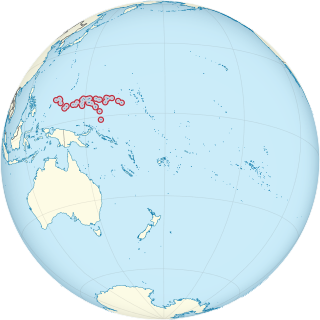
Naval Base Ulithi was a major United States Navy base at the Ulithi Atoll in the Caroline Islands in the western Pacific Ocean, to the north of New Guinea during World War II. The base was built to support the island-hopping Pacific war efforts of the Allied nations fighting the Empire of Japan. In terms of the number of ships at one base, Naval Base Ulithi was the largest naval base in the world in 1944 and 1945, with over 600 ships at times.
McCloskey & Company Shipyard was a ship builder in Tampa, Florida. McCloskey & Company built 38 cargo ships, Type N3 ship for World War II founded in 1942. McCloskey & Company also built type C1-S-D1 concrete ships. Matthew H. McCloskey founded the construction company McCloskey & Company in Philadelphia. McCloskey & Company built the Philadelphia Convention Hall, the Philadelphia Sheraton Hotel, and the Washington D.C. Stadium.
The Tampa shipyard is now Tampa Ship LLC owned by Edison Chouest Offshore.





